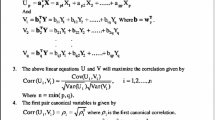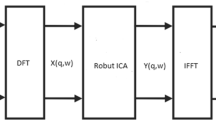Abstract
Independent component analysis (ICA) is a thriving tool in separating blind sources from its determined or over-determined instantaneous mixture signals. FastICA is one of the successful algorithms in ICA. The objective of this paper is to examine various contrast functions using FastICA algorithm, and to find highly performed available contrast function for the application of speech signal analysis in noisy environments. The contrast function is a non-linear function used to measure the independence of the estimated sources from the observed mixture signals in FastICA algorithm. Kurtosis, negentropy and maximum likelihood functions are used as contrast functions in FastICA algorithm. The FastICA algorithm using these contrast functions is tested on the synthetic instantaneous mixtures and real time recorded mixture signals. We evaluate the performance of the contrast functions based on signal to distortion ratio, signal to artifact ratio, signal to interference ratio and computational complexity. The result shows the maximum likelihood function performs better than the other contrast functions in noisy environments.




Similar content being viewed by others
Explore related subjects
Discover the latest articles, news and stories from top researchers in related subjects.Availability of data and supporting materials
Please contact author for data requests.
Abbreviations
- BSE:
-
Blind source extraction
- BSS:
-
Blind source separation
- EVD:
-
Eigen value decomposition
- FA:
-
Factor analysis
- FFT:
-
Fast Fourier transform;
- fMRI:
-
Functional magnetic resonance imaging
- HSS:
-
Heart sound signals
- ICA:
-
Independent component analysis
- LSS:
-
Lung sound signals
- NMF:
-
Non-negative matrix factorization
- PCA:
-
Principal component analysis
- SAR:
-
Signal to artifact ratio
- SCA:
-
Sparse component analysis
- SDR:
-
Signal to distortion ratio
- SIR:
-
Signal to interference ratio
- SNR:
-
Signal to noise ratio
- TFR:
-
Time-frequency representation
References
Acharya, D. P., & Panda, G. (2014). A Review of independent component analysis techniques and their applications. IETE Technical Review, 25(6), 320–332.
Amari, S., & Cichocki, A. (1998). Adaptive blind signal processing—Neural network approaches. Proceedings of IEEE, 86(10), 2026–2048.
Araki, S., Nesta, F., Vincent, E., Koldovsky, Z., Nolte, G., Ziehe, A., & Benichoux, A. (2012). The 2011 signal separation evaluation campaign (SiSec2011): Audio source separation. In Proceedings of international conference on latent variable analysis and signal separation.
Araki, S., & Vincent, E. (2019). https://sisec.inria.fr/home/2016-underdetermined-speech-and-music-mixtures/. Accessed 21.
Bingham, E., & Hyvarinen, A. (2000). A fast fixed point algorithm for independent component analysis of complex valued signals. International Journal of Neural Systems, 10(1), 1–8.
Cardoso, J. F. (1997). Infomax and maximum likelihood for blind source separation. IEEE Signal Processing Letters, 4(4), 112–114.
Chiu, S.-H., Lu, C.-P., Wu, D.-C., & Wen, C.-Y. (2008). Geometric transformation based independent component analysis for mixed image separation. Journal of the Chinese Institute of Engineers, 31(3), 497–502.
Cichocki, A., & Amari, S. (2002). Adaptive signal and image processing: Learning algorithms and applications. New York: Wiley.
Comon, P. (1994a). Tensor diagonalization, a useful tool in signal processing. In Proceedings of IFAC symposium on system identification, Copenhagen, Denmark.
Comon, P. (1994b). Independent component analysis, a newconcept? Signal Processing, 36(3), 287–314.
Delfosse, N., & Loubaton, P. (1995). Adaptive blind separation of independent sources: A deflation approach. Signal Processing, 45(1), 59–83.
Donoho, D. (1980). On minimum entropy deconvolution. In Proceedings of applied time series symposium, Tulsa, Oklahoma.
Hyvarinen, A. (1998). New approximations of differential entropy for independent component analysis and projection pursuit. In Proceedings of advances in neural information processing systems, Denver, Colorado, USA.
Hyvarinen, A. (1999). Fast and robust fixed point algorithms for independent component analysis. IEEE Transactions on Neural Networks, 10(3), 626–634.
Hyvarinen, A., Karhunen, J., & Oja, E. (2001). Independent component analysis, 77. New York: Wiley.
Hyvarinen, A., & Oja, E. (1997a). A fast fixed point algorithm for independent component analysis. Neural Computation, 9(7), 1483–1492.
Hyvarinen, A., & Oja, E. (1997b). One-unit learning rules for independent component analysis. In Proceedings of advances in neural information processing systems, 9.
Hyvarinen, A., & Oja, E. (2000). Independent component analysis: Algorithms and applications. Neural Networks, 13(4–5), 411–430.
Khaliq, A. A., Qureshi, I. M., & Shaha, J. A. (2013). Source extraction from functional magnetic resonance imaging data using ICA based on fourth order and exponential contrast functions. Journal of the Chinese Institute of Engineers, 36(6), 730–742.
Kumar, M., & Jayanthi, V. E. (2019). Underdetermined blind source separation using CapsNet. Soft Computing,. https://doi.org/10.1007/s00500-019-04430-4.
Lacoume, J. L., Gaeta, M. (1990). The general source separation problem. In Proceedings of fifth ASSP workshop on spectrum estimation and Modeling, Rochester, NY, USA.
Luo, M., Li, L., Qian, G., & Liao, H. (2015). Blindly detecting the number of signals using HOS in spatially correlated noise. Journal of the Chinese Institute of Engineers, 38(3), 317–321.
Meinecke, F. C., Harmeling, S., & Müller, K. R. (2004). Robust ICA for super-Gaussian sources. In C. G. Puntonet & A. Prieto (Eds.), Independent component analysis and blind signal separation., ICA 2004. Lecture notes in computer science, 3195 Berlin: Springer.
Nersisson, R., & Noel, M. M. (2016). Heart sound and lung sound separation algorithms: A review. Journal of Medical Engineering & Technology, 41(1), 13–21.
Obradovic, D., & Deco, G. (2006). Information maximization and independent component analysis: Is there a difference? Neural Computation, 10(8), 2085–2101.
Oja, E., & Kiviluoto, K. (1999). Data analysis, visualization and hidden factor discovery by unsupervised learning. In Proceedings of international joint conference on neural networks, Washington, DC.
Pearlmutter, B. A., & Parra, L. C. (1997). Maximum likelihood blind source separation: A context sensitive generalization of ICA. In Proceedings of advances in neural information processing systems, 9.
Pham, D. T. (1996). Blind separation of instantaneous mixtures of sources via an independent component analysis. IEEE Transactions on Signal Processing, 44(11), 2768–2779.
Pham, D. T., & Garrat, P. (1997). Blind separation of mixture of independent sources through a quasi maximum likelihood approach. IEEE Transaction on Signal Processing, 45(7), 1712–1725.
Shalvi, O., & Weinstein, E. (1990). New criteria for blind deconvolution of nonminimum phase systems (channels). IEEE Transaction on Information Theory, 36(2), 312–321.
Tong, L., Liu, R-w, Soon, V. C., & Huang, Y.-F. (1991). Indeterminacy and identifiability of blind indentification. IEEE Transaction on Circuits and Systems, 38(5), 499–509.
Vincent, E., Gribonval, R., & Fevotte, C. (2006). Performance measurement in blind audio source separation. IEEE Transactions on Audio, speech and Language processing, 14(4), 1462–1469.
Wiggins, R. A. (1978). Minimum entropy deconvolution. Geoexploration, 16(1–2), 21–35.
Yangi, O., & Jin, J. (2012). Separation of individual operation signals from mixed sensor measurements. IIE Transactions, 44(9), 780–792.
Acknowledgements
Not applicable.
Funding
Not applicable.
Author information
Authors and Affiliations
Contributions
MK and VEJ participated in the design of study. MK carried out the nemrical experiments and drafted the manuscript. All authors read and approved the final manuscript.
Corresponding author
Ethics declarations
Conflict of interest
The authors declare that they have no competing interests.
Rights and permissions
About this article
Cite this article
Kumar, M., Jayanthi, V.E. Blind source separation using kurtosis, negentropy and maximum likelihood functions. Int J Speech Technol 23, 13–21 (2020). https://doi.org/10.1007/s10772-019-09664-z
Received:
Accepted:
Published:
Issue Date:
DOI: https://doi.org/10.1007/s10772-019-09664-z




